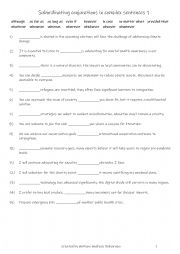
|
B1+-B2 15 subordinating conjunctions in complex sentences part 1
Using subordinating conjunctions allows students to express more detailed and nuanced thoughts. For instance, "although" and "even if" help convey contrast or condition in sophisticated ways. They add variety to writing and speaking, moving beyond simple sentences and making communication more engaging and dynamic. For example, "whenever" or "whoev...
Level: intermediate
Age: 10-100
Type:
Downloads: 112
|
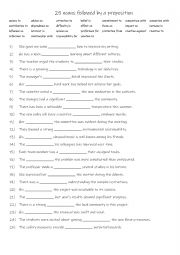
|
B1-B2 25 nouns followed by a preposition
Understanding how to pair nouns with the correct prepositions helps convey ideas more clearly, reducing ambiguity. Many phrases in English are idiomatic; knowing these combinations allows students to speak and write more naturally, as native speakers do. Many of these nouns are relevant in everyday conversations and discussions, making this knowled...
Level: intermediate
Age: 9-100
Type:
Downloads: 107
|
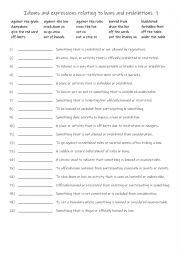
|
B1+-C1 Idioms and expressions relating to bans and prohibitions 1
First, students need to familiarise themselves with the 20 idioms and expressions and their meanings. Then they read the definitions to see which one is being described and write that word in the space provided Answers on page 2.
Level: intermediate
Age: 12-100
Type:
Downloads: 112
|
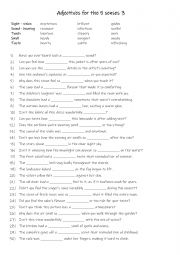
|
A2+-B1 Adjectives for the 5 senses 3
Mastering such language fosters creativity, improves storytelling, and builds confidence in expressing sensory experiences. Ultimately, this enriches their ability to communicate thoughts, emotions, and observations effectively in both academic and real-world settings. First, students need to familiarise themselves with 15 adjectives and check thei...
Level: elementary
Age: 9-100
Type:
Downloads: 105
|
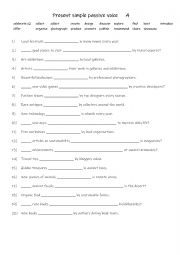
|
Present simple passive voice 4
Learning the present simple passive voice helps students focus on the action or the recipient, rather than the doer. It�s useful when the doer is unknown, unimportant, or to emphasize the object. Mastering this structure improves clarity, variety in sentence construction, and is essential for formal or academic communication. Students complete the ...
Level: elementary
Age: 9-100
Type:
Downloads: 126
|
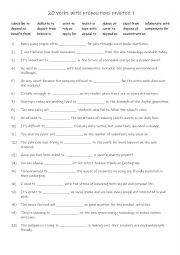
|
B1-B2 20 verbs with prepositions practice 1
B1-B2 20 verbs with prepositions practice 1
Students should learn verb + and preposition phrasal verbs combinations because they are essential for effective communication in both spoken and written English. These expressions help students speak more naturally and fluently, making them sound more like native speakers. They also improve comprehensi...
Level: intermediate
Age: 10-100
Type:
Downloads: 101
|
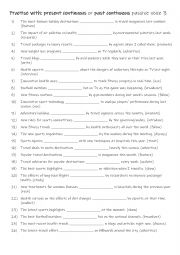
|
A2-B1 Practise with present continuous or past continuous passive voice 3
These tenses enhance precision and fluency when talking about the future. First, students need to familiarise themselves with the 2 tenses and their use. Then they read the sentences to work out which one is needed to complete the gap-fill. Each adverb is used 13 times! Answers on page 2
Level: elementary
Age: 10-100
Type:
Downloads: 119
|
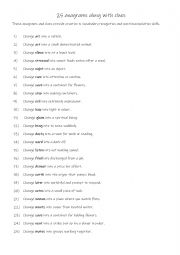
|
25 anagrams along with clues
This worksheet is suitable for A2-B1 level students. It can be used a warmer or a cooler as well and making the student develop thinking skills. The anagrams and clues provide practice in vocabulary recognition and word manipulation skills. Answers on page 2.
Level: elementary
Age: 10-100
Type:
Downloads: 118
|
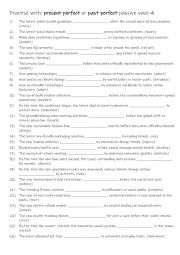
|
B1+-B2 Practise with present perfect or past perfect passive voice 4
Students should learn to practise the present perfect and past perfect passive voice because these structures are vital for expressing completed actions with emphasis on the results rather than the doer. The present perfect passive (e.g., "The work has been finished") is used to discuss actions that affect the present, while the past perfect passiv...
Level: intermediate
Age: 11-100
Type:
Downloads: 111
|
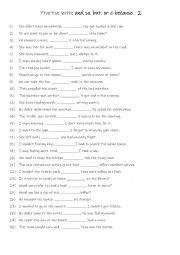
|
A1+- A2 Practise with and, so, but, or & because 2
First, students need to familiarise themselves with the 5 linkers and their usage. Then they read the sentences to see which one is needed to complete the gap-fill. Each conjunction is used 6 times! Answers on page 2.
Level: elementary
Age: 8-100
Type:
Downloads: 116
|












